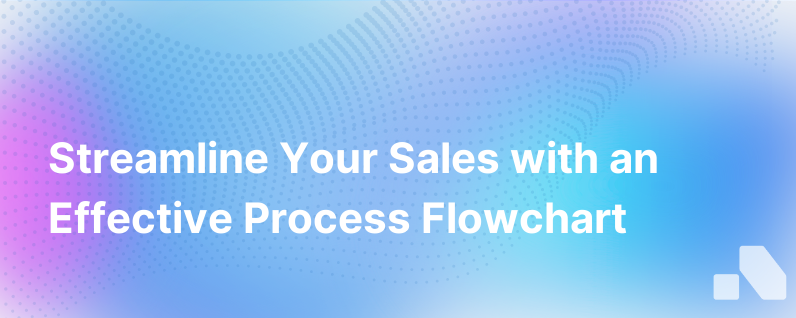
The sales process is the heart of a company’s success and without a clear and effective process, navigating the complex landscape of modern sales can be daunting. To scale revenue and improve efficiency, crafting a comprehensive sales process flowchart is not only beneficial, it's essential.
A sales process flowchart is a visual representation of the stages a prospect moves through within the sales pipeline, from the initial contact to the closing of a deal. It serves as a road map for sales teams, ensuring that no step is skipped and helping to identify bottlenecks or inefficiencies that could hinder the deal flow.
In this article, we’ll deepen your understanding of sales process flowcharts, their significance, and how to create one that drives results. We’ll also explore best practices for implementing the flowchart in your sales activities.
Why a Sales Process Flowchart?
In the realm of B2B sales especially, the path from initial lead to closed-won can be lengthy and convoluted. A well-designed flowchart can illuminate that path, offering several crucial benefits:
- Clarity and consistency: It ensures that every team member understands the steps involved and applies them uniformly.
- Accountability: By clearly delineating responsibilities at each step, a flowchart fosters a culture of accountability.
- Training tool: A flowchart is an excellent training resource for onboarding new sales reps.
- Performance tracking: It simplifies the process of tracking metrics and performance against each step in the sales process.
- Optimization: A visual representation makes it easier to identify and remove inefficiencies.
Anatomy of a Sales Process Flowchart
Your sales process flowchart should reflect the unique aspects of your business, but there are core stages most B2B sales cycles include:
Prospecting
This is the stage where potential leads are identified. At this juncture, the flowchart should branch out, showing different methods of prospecting, for instance, inbound vs. outbound leads.
Qualification
Once potential leads are identified, the qualification process begins to assess whether the prospects match the ideal customer profile (ICP) and have the potential to become valuable customers.
Needs Analysis
After leads are qualified, a deeper dive into the specific needs and pain points of each prospect is crucial. This analysis is pivotal to tailoring your approach for maximum relevance.
Solution Proposal
Armed with the knowledge of the prospect’s needs, the sales process moves to design a solution that fits those needs, often helped by product demonstrations or trials.
Handling Objections
Encountering objections is a natural part of any sales process. Here, the flowchart can suggest pre-planned responses and strategies for common objections.
Closing
This is the finishing line where the prospect becomes a customer through agreement signing and onboarding processes.
Follow-up and Retention
The final stage focuses on post-sale activities to strengthen customer relationships and to encourage repeat business, upsells, and referrals.
Building and Implementing a Sales Process Flowchart
Step 1: Define Each Stage
Start by defining the stages of your current sales process. Gather input from everyone involved in the sales cycle for a comprehensive view.
Step 2: Identify Key Activities
For each stage, list the key activities that occur, who's responsible for them, and any tools or materials needed.
Step 3: Differentiate Decision Points
Include decision points in your flowchart where different outcomes might dictate different paths, like moving forward with a well-qualified lead or returning to prospecting if a lead is unqualified.
Step 4: Design the Flowchart
Leverage flowchart software for a professional visual design. Tools like Microsoft Visio, Lucidchart, or online flowchart creators offer templates and elements to build your flowchart.
Step 5: Review and Optimize
Review your draft with the team. Test the process in real-world scenarios and optimize for any weaknesses or inefficiencies.
Step 6: Distribute and Integrate
Make the flowchart accessible to your team and incorporate it into your CRM system if possible. This ensures that the process is integrated into daily activities.
Step 7: Train Your Team
Train your sales team to understand and follow the flowchart. Emphasize the importance of not skipping steps and how to navigate the decision points.
Step 8: Monitor and Adapt
Regularly review your sales process flowchart to ensure it remains relevant to the ever-changing market dynamics. Collect feedback from your team to make continuous improvements.
Best Practices for Sales Process Flowcharts
Be Specific But Flexible
A flowchart should be detailed enough to provide guidance but flexible enough to accommodate unique situations.
Keep It Visual and Intuitive
Avoid clutter and ensure that your flowchart is easy to follow. Use icons, color coding, and labels effectively.
Collaborate with Multiple Departments
In B2B sales, multiple departments interact with the customer. Collaboration ensures that the flowchart accounts for all these touchpoints.
Ongoing Training is Key
Continuously educate your team about your sales process to ensure that new hires and veterans alike are aligned with the current flow.
Measure and Revise
Use data to analyze the effectiveness of your stages and adapt as needed. Regular revisions will keep the process in tune with customer needs and internal capabilities.
Conclusion
A comprehensive and well-implemented sales process flowchart can vastly improve the structure and success of your sales efforts. It brings visibility to the entire sales process, enabling better forecasting, more cohesive teamwork, and ultimately, more consistent sales success.
For those who want to take their sales process to the next level, platforms like Aomni can help not just in drawing up the flowchart but also in streamlining and automating many areas of the sales process. With the right tools and a clear strategy, your sales process flowchart will serve as the blueprint for sustainable growth in sales performance and customer satisfaction.